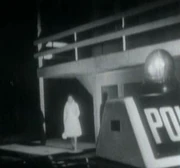(→History: correction) |
(→12 Coronation Street: info added) |
||
| Line 15: | Line 15: | ||
===12 Coronation Street=== |
===12 Coronation Street=== |
||
| − | [[Dave Robbins]] expressed an interest in this two-storey flat, next door to the Barlows, in [[1969]], but |
+ | [[Dave Robbins]] expressed an interest in this two-storey flat, next door to the Barlows, in [[1969]], but his real reason was to move in a squatter family of a mother and three children after her husband had been sent to jail for three years. The occupancy divided the residents of the street along political and moral lines but after a week the family moved out before they could be evicted by Len and the council after a farmer in the Cheshire village of Chelford offered the mother, [[Mrs Storey]], a job and accomodation to go with it. |
===14 Coronation Street=== |
===14 Coronation Street=== |
||
Revision as of 18:30, 29 September 2009

Elsie Tanner outside the maisonettes
The maisonettes in Coronation Street, Weatherfield were a row of flats which stood on the opposite side of the street from 1968 to 1971.
History
The maisonettes were an example of 1960s brutalist architecture and replaced the Glad Tidings Mission Hall and Elliston's Raincoat Factory in Coronation Street. They were built in 1968 but they were unpopular and by 1969 still less than half of them had been lived in.
In 1971, the Barlows, who lived in No. 14, were emigrating to Jamaica, but on the night they were moving out of the maisonette Valerie Barlow was electrocuted in her home and started a fire. The fire exposed structural faults in the building and the council therefore condemned the property and demolished it.
Flats
4 Coronation Street
Widow Effie Spicer lived here from 1968 to 1969.
6 Coronation Street
Ground-floor OAP flat inhabited by Ena Sharples from 1968 to 1971.
12 Coronation Street
Dave Robbins expressed an interest in this two-storey flat, next door to the Barlows, in 1969, but his real reason was to move in a squatter family of a mother and three children after her husband had been sent to jail for three years. The occupancy divided the residents of the street along political and moral lines but after a week the family moved out before they could be evicted by Len and the council after a farmer in the Cheshire village of Chelford offered the mother, Mrs Storey, a job and accomodation to go with it.
14 Coronation Street
Two-storey flat with ground-floor entrance. The Barlow family - Ken, Valerie and twins Peter and Susan Barlow - lived here from 1968 to 1971. The family had previously lived at 9 Coronation Street directly opposite the maisonettes.
Behind the scenes

The rarely-seen maisonette frontage in the first outdoor set
Since 1960, scenes set in the street had been recorded inside a cramped studio, which by 1967 was limiting the realism of the series. Granada Television took the decision to build an outdoor set. At the time, many real world streets like Coronation Street were being demolished and being replaced by tower blocks, which could house many more people in the same space. The modern-looking brutalist maisonettes replaced the outdated Mission hall and factory, reflecting current trends in housing but keeping the actual row of terraced houses that were the centrepoint of the street.
The building of the outdoor set coincided with the storyline of the construction of the maisonettes in 1968.
Unfortunately, the maisonettes weren't the success the producers had initially hoped for. Although the Barlows and Ena Sharples were moved to inhabit the new flats, the casting budget didn't stretch far enough to introduce any new families; Effie Spicer was the only new character brought in to live there, and Effie wasn't in the series for long. Ultimately, the maisonettes were counterproductive as they left the residents with few places to interact as a community and the factory had provided a workplace for younger characters in the 1960s.
In 1971, when Anne Reid chose to leave the series, the writers used the character's death as an opportunity to demolish the maisonettes and replace them with the more traditional Mark Brittain Warehouse and Community Centre.
It wasn't until 1990 that the "other" side of the street would be home to houses again, but space was left for assorted business outlets which would still allow characters to interact in a workplace environment.
